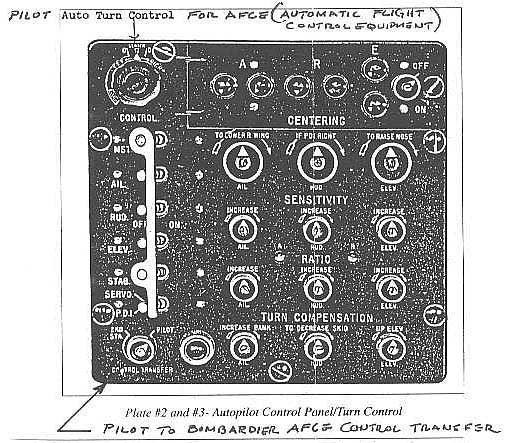The B-17’s Automatic Flight Control Equipment
By Willis Frazier - Operations Officer
601st Squadron, 398th Bomb Group
The letters “AFCE” were an acronym for Automatic Flight Control Equipment. The Automatic Control Panel was located on the instrument control pedestal between the pilots, below the throttles and propeller controls. The AFCE could be reached in flight by the pilot’s right hand for AFCE setup and adjustment of the aircraft’s flying controls. It was also used to transfer the aircraft’s lateral flight control to the bombardier and the Norden bombsight during the bomb run. A photograph of the AFCE control panel is shown below.

The “Auto Turn Control” for the pilot was located in the upper left corner of the control panel. When the lead pilot flew the aircraft on autopilot, he used the turn control for minor adjustments to the flight path of the aircraft. The autopilot provided a stable attitude and steady heading for the lead aircraft. Since the autopilot had no altitude sensor, adjustments had to be watchfully made to the plane’s altitude by the pilot referring to the altimeter on his instrument panel.
A “Control Transfer” switch was located on the lower left corner of the control panel. This switch allowed the pilot to transfer control of the aircraft being flown on autopilot to the bombardier and the Norden bombsight. The bombardier also had a “Auto Turn Control” switch to enable him to perform evasive action while on the bomb run.
I used the automatic pilot on most flights and bomb runs. On bomb runs not on autopilot, the pilot would follow a “Pilot Direction Indicator” on the pilot’s instrument panel. The pilot also had to maintain the plane’s altitude and airspeed while following the needle on his Direction Indicator. Thus, the pilot was very busy while flying manual bomb runs. Flak bursts and flak hitting the plane was also a distraction while on the bomb run. Just a word on the “Sensitivity Control.” While flying on autopilot, I would increase the sensitivity of the ailerons until they chattered, and then back off on the sensitivity just enough to stop the chatter. If one backed off too much the plane’s wings would move too far up or down between autopilot corrections.
There was a major advance in bombing capability when the autopilot was modified to provide lateral control of the aircraft to the Nor ten bombsight for the bomb run The following paragraphs explain these later modifications to the pilot and bombardier’s “Turn Control” switch that were vitally needed for better control of the airplane. The modifications provided a means for the pilot to maneuver a properly banked turn while the airplane was flown under autopilot control without creating violent action. Earlier types of the “Turn/Steer Controls were a separate unit similar to the bombardier remote control knob. The newer design developed by Minneapolis-Honeywell Regular Company placed the turn control on the autopilot panel and made it much easier for the pilot to operate.
Another major modification developed by Minneapolis-Honeywell to the AFCE was an extremely useful one for the bombardier. It provided a convenient and positive means in which evasive maneuvers could be accomplished through the autopilot from the bombardier’s station. The turn knob assembly was installed on top of the stabilizer. The use of that turn knob permitted evasive action more easily and with greater precision. With discretion, the bombardier was able to limit the degree of bank to 12 degrees in either direction for greater safety in formation flying. A book, “The Legendary Norden Bombsight” by Albert L. Pardini, available on a web site, is an excellent reference manual for the information given above.
Transcribed and submitted by:
Wally Blackwell
President - 398th Bomb Group Memorial Association
